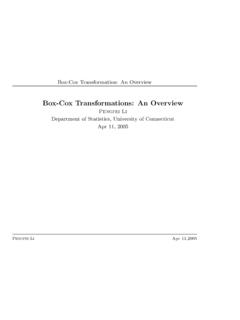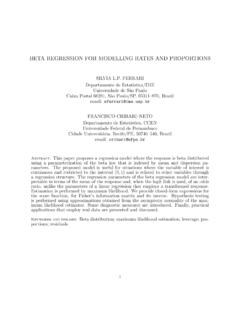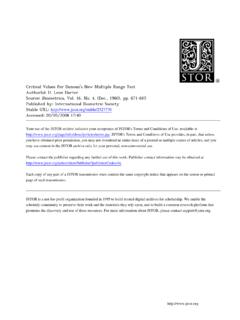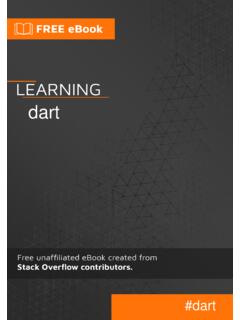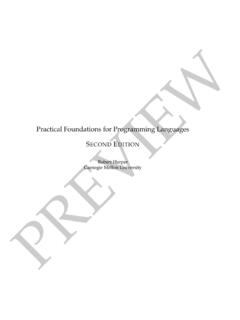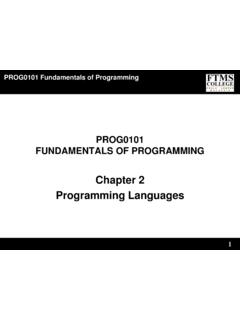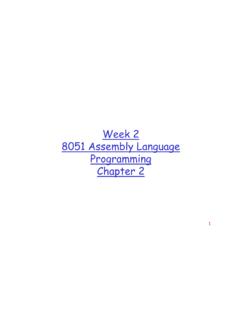Transcription of CONCEPTS OF PROGRAMMING LANGUAGES - IME-USP
1 CONCEPTS OF PROGRAMMING LANGUAGESTENTH EDITIONThis page intentionally left blank CONCEPTS OFPROGRAMMING LANGUAGESTENTH EDITIONROBERT W. SEBESTAU niversity of Colorado at Colorado Springs Boston Columbus Indianapolis New York San Francisco Upper Saddle River Amsterdam Cape Town Dubai London Madrid Milan Munich Paris Montreal TorontoDelhi Mexico City Sao Paulo Sydney Hong Kong Seoul Singapore Taipei TokyoVice President and Editorial Director, ECS: Marcia HortonEditor in Chief: Michael HirschExecutive Editor: Matt GoldsteinEditorial Assistant: Chelsea KharakozovaVice President Marketing: Patrice JonesMarketing Manager: Yez AlayanMarketing Coordinator: Kathryn FerrantiMarketing Assistant: Emma SniderVice President and Director of Production: Vince O BrienManaging Editor: Jeff HolcombSenior Production Project Manager.
2 Marilyn LloydManufacturing Manager: Nick SklitsisOperations Specialist: Lisa McDowellCover Designer: Anthony GemmellaroText Designer: Gillian HallCover Image: Mountain near Pisac, Peru; Photo by authorMedia Editor: Dan SandinFull-Service Vendor: LaserwordsProject Management: Gillian HallPrinter/Binder: Courier WestfordCover Printer: Lehigh-Phoenix ColorThis book was composed in InDesign. Basal font is Janson Text. Display font is ITC Franklin 2012, 2010, 2008, 2006, 2004 by Pearson Education, Inc., publishing as Addison-Wesley. All rights reserved. Manufactured in the United States of America. This publication is protected by Copy-right, and permission should be obtained from the publisher prior to any prohibited reproduction, storage in a retrieval system, or transmission in any form or by any means, electronic, mechanical, photocopying, recording, or likewise.
3 To obtain permission(s) to use material from this work, please submit a written request to Pearson Education, Inc., Permissions Department, One Lake Street, Upper Saddle River, New Jersey 07458, or you may fax your request to of the designations by manufacturers and sellers to distinguish their products are claimed as trade-marks. Where those designations appear in this book, and the publisher was aware of a trademark claim, the designations have been printed in initial caps or all of Congress Cataloging-in-Publication DataSebesta, Robert W. CONCEPTS of PROGRAMMING LANGUAGES / Robert W. Sebesta. 10th ed. p. cm. Includes bibliographical references and index. ISBN 978-0-13-139531-2 (alk. paper)1. PROGRAMMING LANGUAGES (Electronic computers) I. Title. 2009 dc22 200805570210 9 8 7 6 5 4 3 2 1 ISBN 10: 0-13-139531-9 ISBN 13: 978-0-13-139531-2 New to the Tenth EditionChapter 5: a new section on the let construct in functional pro-gramming LANGUAGES was addedChapter 6: the section on COBOL's record operations was removed;new sections on lists, tuples, and unions in F# were addedChapter 8: discussions of Fortran's Do statement and Ada's casestatement were removed; descriptions of the control statements infunctional PROGRAMMING LANGUAGES were moved to this chapter fromChapter 15 chapter 9: a new section on closures, a new section on calling sub-programs indirectly, and a new section on generic functions in F# wereadded.
4 The description of Ada's generic subprograms was removedChapter 11: a new section on Objective-C was added, the chapterwas substantially revisedChapter 12: a new section on Objective-C was added, five new fig-ures were addedChapter 13: a section on concurrency in functional programminglanguages was added; the discussion of Ada's asynchronous messagepassing was removedChapter 14: a section on C# event handling was addedChapter 15: a new section on F# and a new section on support forfunctional PROGRAMMING in primarily imperative LANGUAGES were added;discussions of several different constructs in functional programminglanguages were moved from chapter 15 to earlier chaptersvi PrefaceChanges for the Tenth EditionThe goals, overall structure, and approach of this tenth edition of CONCEPTS of PROGRAMMING LANGUAGES remain the same as those of the nine ear-lier editions.
5 The principal goals are to introduce the main constructs of contemporary PROGRAMMING LANGUAGES and to provide the reader with the tools necessary for the critical evaluation of existing and future PROGRAMMING LANGUAGES . A secondary goal is to prepare the reader for the study of com-piler design, by providing an in-depth discussion of PROGRAMMING language structures, presenting a formal method of describing syntax and introducing approaches to lexical and syntatic tenth edition evolved from the ninth through several different kinds of changes. To maintain the currency of the material, some of the discussion of older PROGRAMMING LANGUAGES has been removed. For example, the descrip-tion of COBOL s record operations was removed from chapter 6 and that of Fortran s Do statement was removed from chapter 8.
6 Likewise, the description of Ada s generic subprograms was removed from chapter 9 and the discussion of Ada s asynchronous message passing was removed from chapter the other hand, a section on closures, a section on calling subprograms indirectly, and a section on generic functions in F# were added to chapter 9; sections on Objective-C were added to Chapters 11 and 12; a section on con-currency in functional PROGRAMMING LANGUAGES was added to chapter 13; a section on C# event handling was added to chapter 14; a section on F# and a section on support for functional PROGRAMMING in primarily imperative lan-guages were added to chapter some cases, material has been moved. For example, several different discussions of constructs in functional PROGRAMMING LANGUAGES were moved from chapter 15 to earlier chapters.
7 Among these were the descriptions of the control statements in functional PROGRAMMING LANGUAGES to chapter 8 and the lists and list operations of Scheme and ML to chapter 6. These moves indicate a significant shift in the philosophy of the book in a sense, the mainstreaming of some of the constructs of functional PROGRAMMING LANGUAGES . In previous editions, all discussions of functional PROGRAMMING language constructs were segregated in chapter 11, 12, and 15 were substantially revised, with five figures being added to chapter , numerous minor changes were made to a large number of sections of the book, primarily to improve VisionThis book describes the fundamental CONCEPTS of PROGRAMMING LANGUAGES by discussing the design issues of the various language constructs, examining the design choices for these constructs in some of the most common LANGUAGES , and critically comparing design serious study of PROGRAMMING LANGUAGES requires an examination of some related topics, among which are formal methods of describing the syntax and semantics of PROGRAMMING LANGUAGES , which are covered in chapter 3.
8 Also, implementation techniques for various language constructs must be con-sidered: Lexical and syntax analysis are discussed in chapter 4, and implemen-tation of subprogram linkage is covered in chapter 10. Implementation of some other language constructs is discussed in various other parts of the following paragraphs outline the contents of the tenth OutlinesChapter 1 begins with a rationale for studying PROGRAMMING LANGUAGES . It then discusses the criteria used for evaluating PROGRAMMING LANGUAGES and language constructs. The primary influences on language design, common design trade-offs, and the basic approaches to implementation are also 2 outlines the evolution of most of the important LANGUAGES dis-cussed in this book. Although no language is described completely, the origins, purposes, and contributions of each are discussed.
9 This historical overview is valuable, because it provides the background necessary to understanding the practical and theoretical basis for contemporary language design. It also moti-vates further study of language design and evaluation. In addition, because none of the remainder of the book depends on chapter 2, it can be read on its own, independent of the other 3 describes the primary formal method for describing the syntax of PROGRAMMING language BNF. This is followed by a description of attribute grammars, which describe both the syntax and static semantics of LANGUAGES . The difficult task of semantic description is then explored, including brief introductions to the three most common methods: operational, denotational, and axiomatic 4 introduces lexical and syntax analysis.
10 This chapter is targeted to those colleges that no longer require a compiler design course in their curricula. Like chapter 2, this chapter stands alone and can be read independently of the rest of the 5 through 14 describe in detail the design issues for the primary constructs of PROGRAMMING LANGUAGES . In each case, the design choices for several example LANGUAGES are presented and evaluated. Specifically, chapter 5 covers the many characteristics of variables, chapter 6 covers data types, and chapter 7 explains expressions and assignment statements. chapter 8 describes control Preface viiviii Prefacestatements, and Chapters 9 and 10 discuss subprograms and their implementa-tion. chapter 11 examines data abstraction facilities. chapter 12 provides an in-depth discussion of language features that support object-oriented PROGRAMMING (inheritance and dynamic method binding), chapter 13 discusses concurrent program units, and chapter 14 is about exception handling, along with a brief discussion of event last two chapters (15 and 16) describe two of the most important alterna-tive PROGRAMMING paradigms: functional PROGRAMMING and logic PROGRAMMING .
